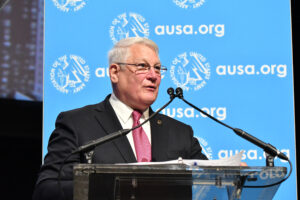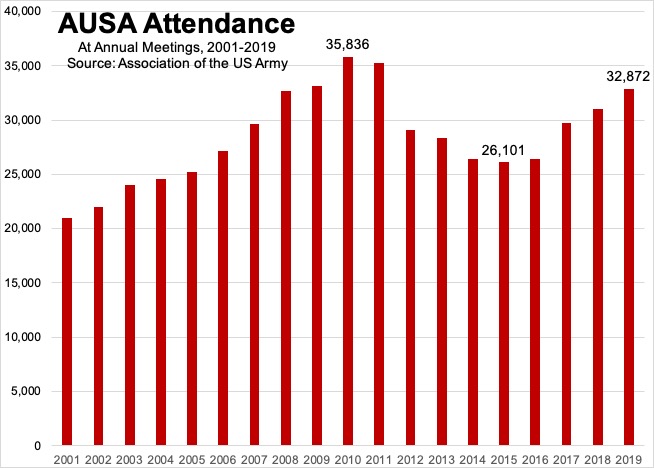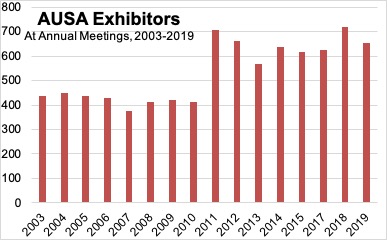By SYDNEY J. FREEDBERG JR.
 WASHINGTON: Every October, the Walter E. Washington convention center in downtown DC – a behemoth building covering two whole city blocks – fills with soldiers, contractors, and reporters. Over 30,000 people pack shoulder-to-shoulder in conference rooms to hear from Army leaders, speak face to face, line up for fried chicken, shake hands, hug, and handle military hardware from prototype rifles to full-sized tanks. But with COVID-19 cases rising alarmingly around the country, none of that will happen this October.
WASHINGTON: Every October, the Walter E. Washington convention center in downtown DC – a behemoth building covering two whole city blocks – fills with soldiers, contractors, and reporters. Over 30,000 people pack shoulder-to-shoulder in conference rooms to hear from Army leaders, speak face to face, line up for fried chicken, shake hands, hug, and handle military hardware from prototype rifles to full-sized tanks. But with COVID-19 cases rising alarmingly around the country, none of that will happen this October.
“We’ve made the difficult decision to convert the 2020 AUSA Annual Meeting from an in-person meeting to a virtual experience,” said retired Gen. Carter Ham, the Association of the US Army’s president and CEO, in a statement Tuesday afternoon. The mega-conference – historically one of the biggest in-person gatherings for the defense industry in the DC area – will now take place entirely online over Oct. 13-16. Breaking Defense plans to cover the virtual event as exhaustively (and as exhaustingly for our reporters) as it has the physical one every year since 2011.
“With recent trends, it just became clear to me that we simply could not, in any reasonable manner, ensure a safe, secure environment for the 32,000-plus people we expected this October,” Gen. Ham told me in an follow-up email. “We are working very closely with the Army to craft an agenda which provides opportunities for key leaders to connect with our members and constituents.”
“One of the keys to that is finding ways to connect Army leaders with the businesses, large and small, who normally are present in the exhibition hall,” Ham said. “Finding a way to do something similar to that experience in the virtual world will be a challenge, but it is an integral part of the AUSA Annual Meeting, so we’ll figure it out.”

Breaking Defense graphic from AUSA data
AUSA is still working out the logistics of this massive switch. Registrations and sponsorship agreements from the in-person version of the event will not automatically carry over. “Registration for the new virtual meeting is expected to open by September,” the AUSA statement says. “AUSA is now coordinating details for the virtual event, and team members will be reaching out directly to exhibitors and sponsors about new opportunities.”
With over 600 sponsors in a typical year – ranging from small businesses with a single, small booth to titans like Boeing and Lockheed Martin – the Annual Meeting is a major source of revenue for AUSA. How this will impact the association’s budget is unclear – even to AUSA itself at this point.

Breaking Defense graphic from AUSA data
“The AUSA Annual Meeting is our most important revenue-generating event of the year,” Ham said bluntly. “The revenue from this event is largely what allows us to conduct other events throughout the year. So, I don’t know yet precisely what the impact will be, but there will be some effect. Fortunately, AUSA is in a strong financial position so we will be able to sustain this change.”
AUSA’s latest annual report said the 2018 conference “generated $16 million in revenue,” just under half the association’s total projected revenue of $33 million for the 2018-2019 fiscal year. (The report for 2019-2020 hasn’t been published yet). But AUSA also reported its investment portfolio was worth $51 million; that was as of May 2019, before COVID roiled the stock market, but the portfolio should still be large enough to offer at least some buffer.
The initial wave of the COVID-19 coronavirus forced AUSA to cancel its Global Force conference in Huntsville, Ala. this March just a week ahead of opening day. That gave the association no time to schedule virtual alternatives, although multiple events from Army aircraft announcements to Shark Tank-style pitch meetings were hastily turned into teleconferences or webcasts.
Global Force had expected some 6,000 attendees. Since then, AUSA has held a host of online events, largely but by no means entirely without glitches, but they were all much smaller in scale. The Annual Meeting had expected some 33,000 attendees. Moving that conference online will be a vastly larger organizational and technical challenge.
It’s also an opportunity, Ham argued. “While we will all certainly miss the opportunity to be together with the broader Army Family, choosing to provide our programs in a virtual environment does offer us an opportunity to connect with audiences who might not know AUSA all that well or who have simply not been able to travel to Washington DC for the event in prior years,” he told me. “I view this very much as a chance to extend our reach and to more effectively fulfill our mission to support the Army.”
Even if nothing glitches, though, the virtual Annual Meeting won’t replace the human connection that came from the Army’s annual gathering of its disparate tribes.
“What will I miss? This is the Army’s family reunion,” Ham said. “Every October, the opportunity to see old friends and to make new friends is the most enjoyable part of the Annual Meeting. I’ll miss that, to be sure, but I also know that via this virtual experience, we will make new connections, new relationships that will make AUSA 2021 even better when we can all be together again.”
No comments:
Post a Comment